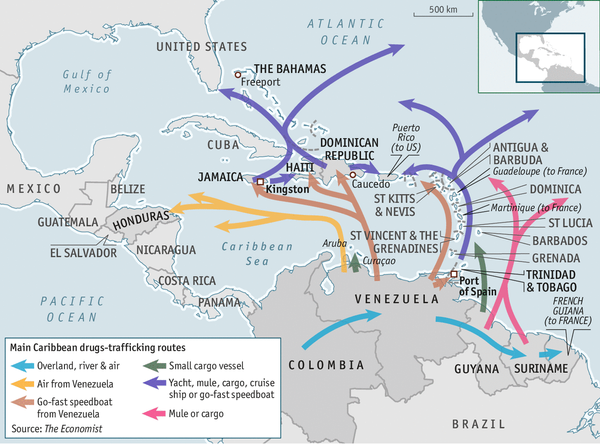Drugs trafficking in the Caribbean
William Brownfield, the State Department’s senior anti-drugs official, says that 16% of cocaine imports into the United States came through the Caribbean islands last year. That is up from 4% in 2011. For European cocaine imports, the proportions are even higher.
The rising volume of drugs coming through the Caribbean is an example of what drugs wonks call the “balloon effect”, the idea that increased pressure on one drug route produces a bulge elsewhere. Until recently, the favoured northbound route for cocaine from South America—principally via Venezuela, after Colombia’s interdiction efforts in the 1990s—was by small aircraft to Honduras. Planes fly a dogleg path—first north, then west—to avoid Colombian airspace; the drugs then move by land or other means via Central America and Mexico.
Last year Honduras stepped up its counter-narcotics pressure. Drug flights to Central America dropped by a third and traffickers were pushed east to the Caribbean islands. That brings a chunk of the drug trade full circle, back to the 1980s when the likes of Pablo Escobar, a Colombian kingpin, used the islands as their route to market. It is “likely to get worse before it gets better”, Mr Brownfield told a group of Caribbean police commissioners in April.
The uptick in volumes is nothing but bad news for the Caribbean. International gangs, from Mexico’s Sinaloa group to the Italian ’Ndrangheta, are becoming more entrenched. They work with local counterparts who may be paid in kind with a percentage of the shipment and perhaps a few guns. Local demand for cocaine is low; the main intra-island trade is in marijuana. But multiplying shipments mean more gang members and more officials to bribe. The Caribbean already has some of the world’s highest murder rates. The trafficking revival will do nothing to bring them down.
Click here to read the full article.
Keep up-to-date with drug policy developments by subscribing to the IDPC Monthly Alert.
